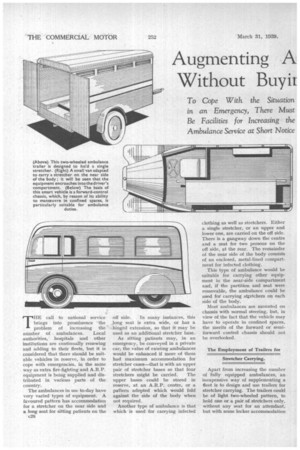Augmenting A Without Buy it ulance Services Extra Vehicles
Page 82

Page 83

If you've noticed an error in this article please click here to report it so we can fix it.
THE call to national service brings into prominence the problem of increasing the number of ambulances. Local authorities, hospitals and other institutions are continually renewing and adding to their fleets, but it is considered that there should be suitable vehicles in reserve, in order to cope with emergencies, in the same way as extra fire-fighting and A.R.P. equipment is being supplied and distributed in various parts of the country.
The ambulances in use to-day have very varied types of equipment. A favoured pattern has accommodation for a stretcher on the near side and a long seat for sitting patients on the e28 off side. In many instances, this long seat is extra wide, or has a hinged extension, so that it may be used as an additional stretcher base.
As sitting patients may, in an emergency, be conveyed in a private car; the value of existing ambulances would be enhanced if more of them had maximum accommodation for stretcher cases that is with an upper pair of stretcher bases so that four stretchers might be carried. The upper bases could be stored in reserve, at an A.R.P. centre, or a pattern adopted which would fold against the side of the body when not required.
Another type of ambulance is that which is used for carrying infected clothing as well as stretchers. Either a single stretcher, or an upper and lower one, are carried on the off side. There is a gangway down the centre and a seat for two persons on the off side, at the rear. The remainder of the near side of the body consists of an enclosed, metal-lined compartment for infected clothing.
This type of ambulance would be suitable for carrying other equipment in the near-side compartment and, if the partition and seat were removable, the ambulance could be used for carrying stretchers on each side of the body.
Most ambulances are mounted on chassis with normal steering, but, in view of the fact that the vehicle may have to operate in confined spaces, the merits of the forward or semiforward control chassis should not be overlooked.
The Employment of Trailers for Stretcher Carrying.
Apart from increasing the number of fully equipped ambulances, an inexpensive way of supplementing a fleet is to design and use trailers for stretcher carrying. The trailers could be of light two-wheeled pattern, to hold one or a pair of stretchers only, without any seat for an attendant, but with some locker, accommodation for dressings, splints and other firstaid equipment. These trailers would be from 8 ft. to 0 ft. long and would vary in width, according to whether one or a pair of stretchers was carried. The headroom would be about 4 ft. 6 ins.
Such a trailer could be drawn by an ambulance, private car, or any other vehicle available. There would have to be a towing hook of a specified height and pattern in order to ensure that, with a minimum of adjustment, the trailer could be attached and maintain an even keel.
There could be a pair of back doors and louvre panels, with or without small windows of " opaque " glass, or ventilators could be inserted in the roof and above the back doors.
A Way to Arouse the Van Owner's Interest.
Another method of increasing the number of ambulances, in an emergency, would he to encourage the van owner, perhaps by means of a small subsidy, to specify bodywork which, whilst meeting his everyday requirements for a goodscarrying vehicle, would, at the same
time, be easily converted for carrying.one or more stretchers.
A van to .serve this dual purpose should be not less than 7 ft. 6 ins. long inside, behind the front bulkhead. The van with inside wheelarches would be provided with a stretcher base hinged to the body side, so that it could be folded out of the way when not required. If the bulkhead has a near-side opening or sliding door, then the stretcher base should be placed on the off side.
Apart from the stretcher base, the van should have some scheme of ventilation, also some natural as well as electrical lighting. The windows could be in a clerestory roof or small windows could be inserted in the sides of the body.
For smaller vans which are restricted as to length, a stretcher could extend on the near side into the driving compartment, after any seat on this side had been removed. A space of not less than 2 ft. wide would be required, measured, preferably, from the inside face of the wheel-arch:
If the stretcher rests inside, rather than on top of the wheel-arch, then it should be brought closer to the longitudinal centre of the body, thus allowing for any contraction of the width of the driving compartment where the front doors curve inwards towards the .dash.
























































































































































